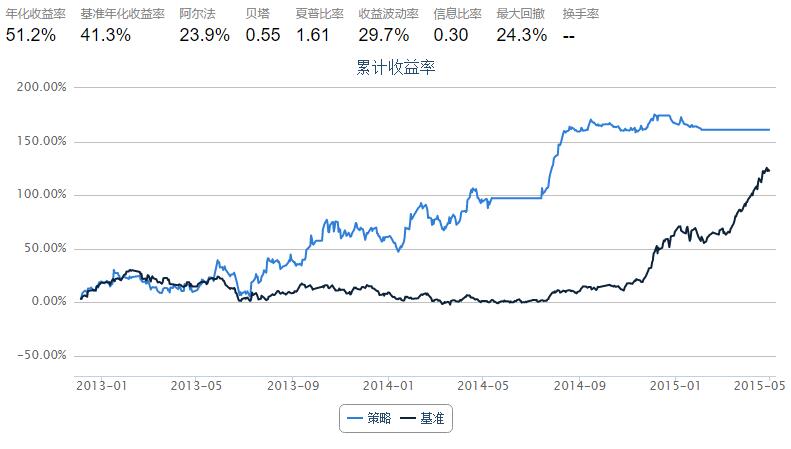5.10 PAMR · PAMR : 基于均值反转的投资组合选择策略 - 修改版
策略思路:
该策略的主要思想是用一个损失函数反映均值反转性质,即如果基于前一期相对价格的预期收益值大于一定阈值,损失值将线性增长;否则,损失为0
策略实现
m个资产每日调仓:对每个资产,收益高于总资产平均收益者,减持;收益低于总资产平均收益者,增持
具体参见文献: http://citeseerx.ist.psu.edu/viewdoc/download?doi=10.1.1.421.579&rep=rep1&type=pdf
from CAL.PyCAL import *
from numpy import *
import pandas as pd
import numpy as np
from pandas import DataFrame
import cvxopt
from cvxopt import matrix
from cvxopt.blas import dot
import cvxopt.solvers as cs
# parameters used in updatePAMR
sensitivity = 0.8
C = 600
start = datetime(2012, 12, 1)
end = datetime(2015, 5, 1)
benchmark = 'HS300'
universe = set_universe('SH180')
capital_base = 1e8
refresh_rate = 1
window = 1
tickers = [stk[0:6] for stk in universe]
portfolio = DataFrame(1.0, index = universe, columns = ['prePosition', 'position', 'relative_price'])
def initialize(account):
account.amount = capital_base
account.universe = universe
account.days = 0
def handle_data(account):
today = account.current_date
today_str = today.strftime("%Y%m%d")
for stk in universe:
hist_close = account.get_attribute_history('closePrice', 2)
hist_pre_close = account.get_attribute_history('preClosePrice', 2)
try:
portfolio['relative_price'][stk] = hist_close[stk][-1]/hist_pre_close[stk][-1]
#print stk, today_str, portfolio['relative_price'][stk]
except:
continue
portfolio['relative_price'] = portfolio['relative_price'].fillna(1.0)
portfolio['prePosition'] = portfolio['position']
a = portfolio['prePosition']
b = portfolio['relative_price']
portfolio['position'] = normalizePortfolio(updatePAMR(a, b, sensitivity, C))
for stk in portfolio.index:
try:
stk_amount = capital_base*portfolio['position'][stk]/hist_close[stk][-1]
order_to(stk, stk_amount)
except:
continue
def lossFunction(portfolio, relative_price, sensitivity):
# define a e-insensitive loss function
# portfolio vector: b
# price relative vector: x
# sensitivity parameter: e
# then: loss = max(0, dot(x,b) - e)
portfolio_return = portfolio.transpose().dot(relative_price)
if portfolio_return < sensitivity:
return 0
else:
return portfolio_return - sensitivity
def normalizePortfolio(portfolio):
# original portfolio vector: b_origin
# find b = argmin(|b - b_origin|^2) under condition:
# sum(b_i) = 1 and b_i > 0 for all i
# solve the problems using Quadratic Programming Method:
# http://abel.ee.ucla.edu/cvxopt/userguide/coneprog.html#quadratic-programming
n = portfolio.shape[0]
S = cvxopt.matrix(0.0, (n,n))
S[::n+1] = 1.0
S = S.T*S
pbar = cvxopt.matrix(portfolio.values).T*(S + S.T)
pbar = pbar.T
G = cvxopt.matrix(0.0, (n,n))
G[::n+1] = -1.0
h = cvxopt.matrix(0.0, (n,1))
A = cvxopt.matrix(1.0, (1,n))
b = cvxopt.matrix(1.0)
cvxopt.solvers.options['show_progress'] = False
x = cs.qp(S, -pbar, G, h, A, b)['x']
b = portfolio.copy()
for i in range(0, n):
b.ix[b.index[i]] = x[i]
return b
def updatePAMR(portfolio, relative_price, sensitivity, C):
# update portfolio by PAMR2 methods:
# PAMR: Passive Aggressive Mean Reversion Strategy for Portfolio Selection.
# Bin Li, Peilin Zhao, Steven C.H. Hoi, and V. Gopalkrishnan.
# Machine Learning, 2012, 87(2), 221 - 258.
loss = lossFunction(portfolio, relative_price, sensitivity)
avg_ret = relative_price.sum()/relative_price.shape[0]
tmp = ((relative_price - avg_ret)**2).sum() + 1.0/2/C
tau = loss/tmp
return portfolio - tau*(relative_price - avg_ret)
